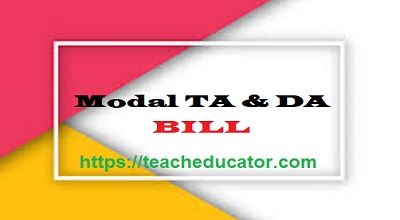Model TA and DA Bill
The latest Model TA and DA Bill is here. It seems like you’re referring to “TA” and “DA” in the context of a bill, which typically stands for Travel Allowance (TA) and Dearness Allowance (DA). These terms are often used in the context of employment or business expenses. Let me provide some brief explanations for each:
Travel Allowance (TA):
- Definition: A travel allowance is a payment made to employees to cover their expenses. When they are required to travel for business purposes.
- Purpose: It is meant to reimburse employees for the expenses they incur while traveling. Such as transportation, accommodation, and meals.
Dearness Allowance (DA):
- Definition: Dearness Allowance is an additional amount paid to employees. As a cost of living adjustment to compensate for inflation and the rising cost of living.
- Purpose: DA is designed to mitigate the impact of inflation on the purchasing power of employees’ salaries, ensuring. That their real income remains relatively stable.
As for the term “bill,” it could refer to a document that outlines and records these allowances for reimbursement or payment. A travel or expense reimbursement bill might include details about the expenses incurred during travel. It would specify the amount to be reimbursed to the employee. Similarly, a bill related to Dearness Allowance might detail the additional amount to be paid to employees to account for changes in the cost of living.
If you have a specific context or if “TA” and “DA” mean something different in your scenario, please provide more details so I can offer more accurate information.
How to apply for the Model TA and DA Bill?
The process for applying for Travel Allowance (TA) and Dearness Allowance (DA) reimbursement typically varies depending on the organization, company policies, and local regulations. Below are general steps that you might follow, but it’s important to note that these procedures can differ:
Travel Allowance (TA) Reimbursement:
Understand Company Policies:
- Familiarize yourself with your organization’s travel policy. This will outline the eligible expenses, submission requirements, and any specific guidelines.
Record Expenses:
- Keep detailed records of all eligible expenses incurred during your business travel. This may include receipts for transportation, accommodation, meals, and other related costs.
Complete Expense Report:
- Typically, companies have an expense report or reimbursement form. Complete the form accurately, providing all necessary details about each expense.
Attach Receipts:
- Attach original receipts or copies as required. Receipts serve as evidence of the expenses you are claiming for reimbursement.
Submit to the relevant department:
- Submit the completed expense report along with receipts to the designated department or individual responsible for processing travel reimbursements.
Approval and Reimbursement:
- Your request will be reviewed, and if everything is in order, it will be approved. The reimbursement will then be processed. You should receive the approved amount in your paycheck or through another specified method.
Dearness Allowance (DA) Adjustment:
Review the employment contract:
- Check your employment contract or company policy to understand how Dearness Allowance adjustments are made.
Wait for Periodic Review:
- In many cases, DA adjustments are made periodically based on the inflation rate or cost of living changes. You may not need to apply for DA directly. As it is often handled by the human resources or finance department.
Communication with HR:
- If you have specific concerns or questions about Dearness Allowance, communicate with the human resources department. They can provide information about the company’s policy and procedures.
Update Personal Information:
- Ensure that your personal information, such as your current address and bank details. Is up-to-date in the company records to facilitate any direct adjustments to your compensation.
Final Words
It’s important to note that the steps outlined above are general guidelines. The specific procedures may vary depending on your organization’s policies. If you are unsure about the process, it’s recommended to reach out to your HR. Or the finance department for guidance specific to your situation.
